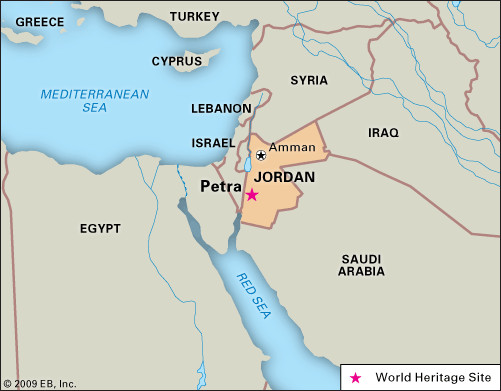Petra, a mesmerizing ancient city carved into sandstone cliffs, continues to captivate travelers and historians alike. Often referred to as the “Lost City,” its dramatic rock-cut architecture and rich history spark immense curiosity, particularly regarding its location. So, where is Petra, Jordan? Let’s delve into the geographical and historical context of this wonder of the world.
Petra is nestled in the southwestern region of Jordan, a country in the Middle East. More specifically, it lies in a basin among the rugged sandstone mountains that form the eastern flank of Wadi Araba, the large valley running from the Dead Sea to the Gulf of Aqaba. The city is strategically situated on a terrace that is traversed by Wadi Musa, also known as the “Valley of Moses.” Tradition holds that this valley is one of the places where Moses, the revered Israelite leader, struck a rock, and water miraculously flowed forth. This area, characterized by its vividly colored sandstone cliffs ranging from deep reds and purples to pale yellows, led the 19th-century scholar John William Burgon to famously describe Petra as “a rose-red city half as old as Time.” The modern town of Wadi Musa now stands adjacent to the ancient site, primarily serving the numerous tourists who journey to experience Petra’s grandeur.
Historically, Petra’s location was pivotal to its prosperity. Originally known as Sela in biblical times, and later adopting the Greek name Petra, meaning “rock,” the area has a long history of habitation. Archaeological evidence indicates human presence dating back to the Paleolithic and Neolithic periods. Around 1200 BCE, the Edomites are known to have inhabited the region. However, it was the Nabataeans, an Arab tribe, who truly transformed Petra into a significant urban center, establishing it as the capital of their kingdom. By the 4th century BCE, Petra was flourishing. Its strategic position at the crossroads of ancient trade routes connecting China, India, Egypt, Greece, and Arabia, made it a vital hub for the lucrative spice trade. This brought immense wealth and growth to Petra, with its population estimated to have swelled to between 10,000 and 30,000 inhabitants. The Nabataeans were skilled traders and engineers, renowned for their ability to manage water resources in the arid desert environment, further contributing to Petra’s success.
 Overview of Petra, a UNESCO World Heritage Site in Jordan, showcasing its unique landscape.
Overview of Petra, a UNESCO World Heritage Site in Jordan, showcasing its unique landscape.
In 106 CE, the Romans conquered the Nabataean kingdom, and Petra was annexed into the Roman province of Arabia. While Petra continued to be an important city under Roman rule, changes in trade routes gradually led to its commercial decline. A devastating earthquake in 551 CE further impacted the city, leading to a significant decrease in habitation. Following the Islamic invasion in the 7th century and a Crusader presence in the 12th century, Petra faded from Western awareness. It remained largely unknown to the Western world until its rediscovery in 1812 by Swiss traveler Johann Ludwig Burckhardt. His remarkable feat of exploration brought Petra back into the global spotlight, sparking immense interest in its history and archaeology.
Today, Petra is Jordan’s most visited tourist attraction and a UNESCO World Heritage site, designated in 1985. The journey to Petra often begins in Amman, Jordan’s capital, from where visitors travel south to Wadi Musa. The entrance to Petra itself is through the Siq, a narrow and breathtaking gorge that winds for over a kilometer. Emerging from the Siq, the first and most iconic monument to greet visitors is the Treasury (Al-Khazneh), an awe-inspiring facade carved directly into the sandstone cliff. Beyond the Treasury, Petra unfolds to reveal a vast array of temples, tombs, dwellings, and other structures, including the Monastery (Ad Deir), another colossal monument reached by a long climb, and numerous elaborate royal tombs. The High Place of Sacrifice offers panoramic views and insights into Nabataean religious practices. Petra’s intricate water management system, with its dams, cisterns, and channels, stands as a testament to the ingenuity of its ancient inhabitants.
 The iconic Khaznah (Treasury) in Petra, Jordan, famous for its intricate facade.
The iconic Khaznah (Treasury) in Petra, Jordan, famous for its intricate facade.
The allure of Petra lies not only in its stunning architecture and historical significance but also in its dramatic natural setting. The vibrant colors of the sandstone, sculpted by wind and water over millennia, create a breathtaking backdrop for the city’s monuments. Despite the challenges posed by natural elements and increasing tourism, efforts are ongoing to preserve this invaluable archaeological site. Petra’s designation as a UNESCO World Heritage site underscores its universal value and ensures its protection for future generations.
 The Siq, the dramatic narrow canyon entrance to Petra, Jordan.
The Siq, the dramatic narrow canyon entrance to Petra, Jordan.
In conclusion, Petra is geographically located in southwestern Jordan, a country in the Middle East, nestled in a basin within the Shara Mountains. Its historical importance stems from its strategic position on ancient trade routes and the ingenuity of the Nabataean civilization. Rediscovered in the 19th century, Petra continues to inspire awe and wonder, inviting travelers to explore the legacy of this remarkable city carved in stone and understand why it remains an essential destination for anyone seeking to witness the wonders of the ancient world.
